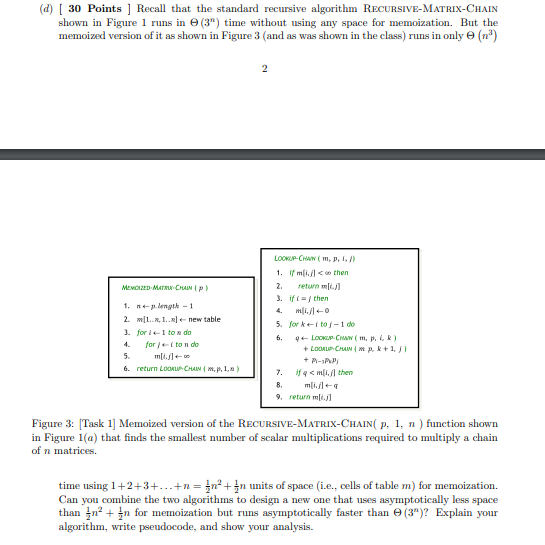Home /
Expert Answers /
Computer Science /
d-30-points-recall-that-the-standard-recursive-algorithm-recursive-matrix-chain-shown-in-figur-pa616
(Solved): (d) [ 30 Points ] Recall that the standard recursive algorithm Recursive-Matrix-Chain shown in Figur ...
(d) [ 30 Points ] Recall that the standard recursive algorithm Recursive-Matrix-Chain
shown in Figure 1 runs in \Theta (3^(n)) time without using any space for memoization. But the
memoized version of it as shown in Figure 3 (and as was shown in the class) runs in only \Theta (n^(3))p m[1..\pi ,1..\pi ]<= new table
for l<1 to x do
for ()/(s)=i toln do
m[i,j]larr\infty m,p,1,2 m[i,j]< on then
return m i,j
if f=f then
m[i,f]larr0
for klarri to j-1 do
Loonup Crum (w)p,k+1,j
(+)/(b)ar (p)_(1-1)vec(A)_(n)p_(j)
if ,m[i,j]larrqp,1,nn1+2+3+dots+n=(1)/(2)n^(2)+(1)/(2)nm(1)/(2)n^(2)+(1)/(2)n\Theta (3^(n))Q then
,m[i,j]larrq
return m[i.j]
Figure 3: [Task 1] Memoized version of the Recursive-Matrix-Chain ( p,1,n ) function shown
in Figure 1(a) that finds the smallest number of scalar multiplications required to multiply a chain
of n matrices.
time using 1+2+3+dots+n=(1)/(2)n^(2)+(1)/(2)n units of space (i.e., cells of table m ) for memoization.
Can you combine the two algorithms to design a new one that uses asymptotically less space
than (1)/(2)n^(2)+(1)/(2)n for memoization but runs asymptotically faster than \Theta (3^(n)) ? Explain your
algorithm, write pseudocode, and show your analysis. RECURSIVE-MATRIX-CHAIN (p,i,j)
if i=j then
return 0
qlarr\infty
for klarri to j-1 do
ReCURSIVE-MATrix-Chain (p,k+1,j)
return q
